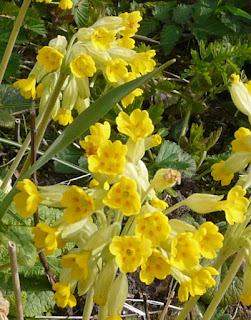The two pictures above show the typical cowslip with completely yellow petals save five orange spots on the inside.
Some flowers have a thin orange border to the petals.
Some flowers are a deep orange, almost red, with contrasting yellow centres.
For comparison, this is an oxslip, Primula elatior, showing no orange at all.
To find the proportion of plants showing the orange colouring I counted them. This is not straightforward.
Each plant is either yellow or orange, all the flowers on each spike and each spike on a single plant being the same. Yellow and orange plants grow in close proximity, ruling out an environmental control of colour. It is therefore assumed that the colour variation is genetically controlled. As can be seen in the photos, there is a clear distinction between yellow and orange but within the orange group there is a variation in the degree of orange colouration. I have therefore divided them between yellow and orange, grouping all flowers displaying any orange (other than the ubiquitous five spots) into one group.
Most of the plants are now over three years old, having been germinated from seed in the autumn of 2013, raised in seed trays then planted out into a nursery bed in summer 2014 and then replanted in autumn 2014 and spring 2015. Many of the plants have grown into clumps by vegetative spreading and have many flower spikes each. It is assumed that each clump is a genetic clone, having arisen from one seed, and so each such clump was counted once, rather than each flower spike being counted. This may introduce some degree of error since a few of the clumps may comprise two or three genetically distinct plant if, during the seedling pricking out and subsequent replanting two or three seedlings growing very close together were treated as one plant. This was illustrated in four clumps showing both yellow and orange spikes but close inspection showed that these originated from separate plants in close proximity. That this occurred but only occurred four times suggests that there is likely to be some bias of under-counting of yellow plants but that this bias is small.
195 clumps of cowslips were recorded.
Yellow: 145 76%
Orange: 50 26%
Taking into account the possible pro-yellow bias in the counting described above, it is concluded that between a fifth and a quarter of the plants have the genetic trait that produces the orange colouring.
The study of colour variation in cowslips is nothing new. This is from Charles Darwin, 'The Variation of Animals and Plants Under Domestication, Volume 2' published in 1868:
And then there's heterostyly.
Biff Vernon, 22/04/2016
Responses:
Laura Kidd posted these pictures of red cowslips on the facebook group The Wild Plant Group of UK & Ireland.
She recorded them near Thame in Oxfordshire. Growing in a semi-natural area, Laura estimated that between 5 and 10% were this colour, the rest being the normal yellow.













Dear Biff,
ReplyDeleteFirstly my apologies for not having appreciated that you had sent me a comment some months ago. I have looked at your photos with interest and have not previously seen any varieties with the dark outside colour. At this point I am unable to comment on this aspect, and have to stick to the variable red centres. In all the species I have quoted I have verified to my satisfaction the combination of variation in the amount of red together with the difference between Lindrick west of Worksop and Peak district sites. This gives me confidence in the aspect of variable red and the similarity to the butterfly. There may be other aspects of variation in addition to the particular type of hybrid mechanism which I have been dealing with: it would take time and several checks on site to be able to comment further on your darker coloured specimens. I'm quite satisfied that at present their occurrence does not invalidate the combination I mention. Incidentally more recently I have information blogged on Bird's-foot Trefoil.
Regards, Bill Smyllie